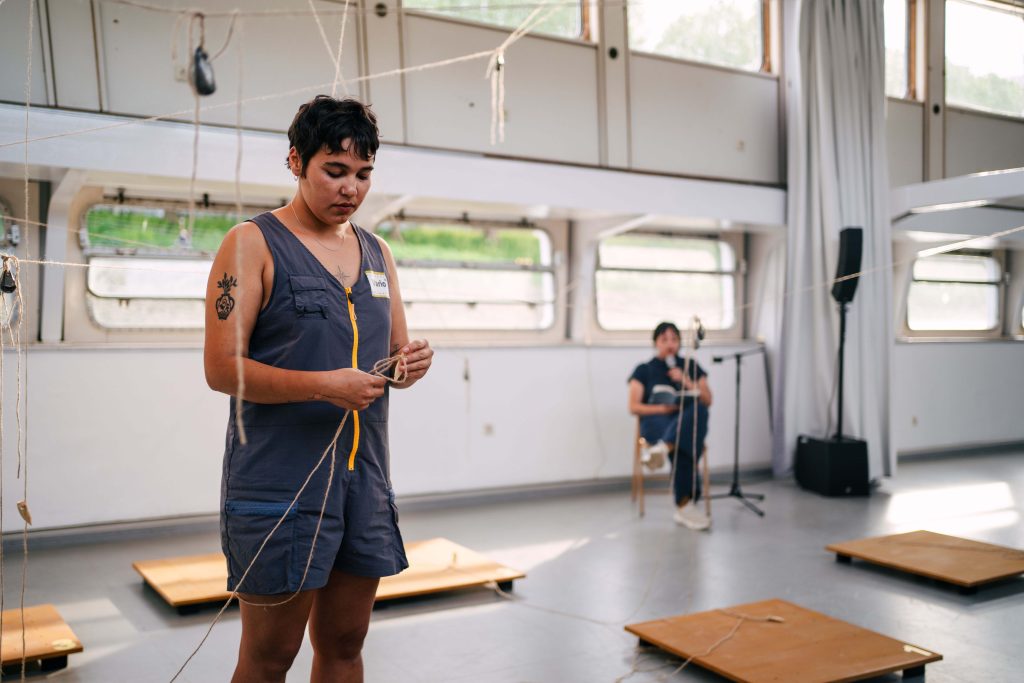
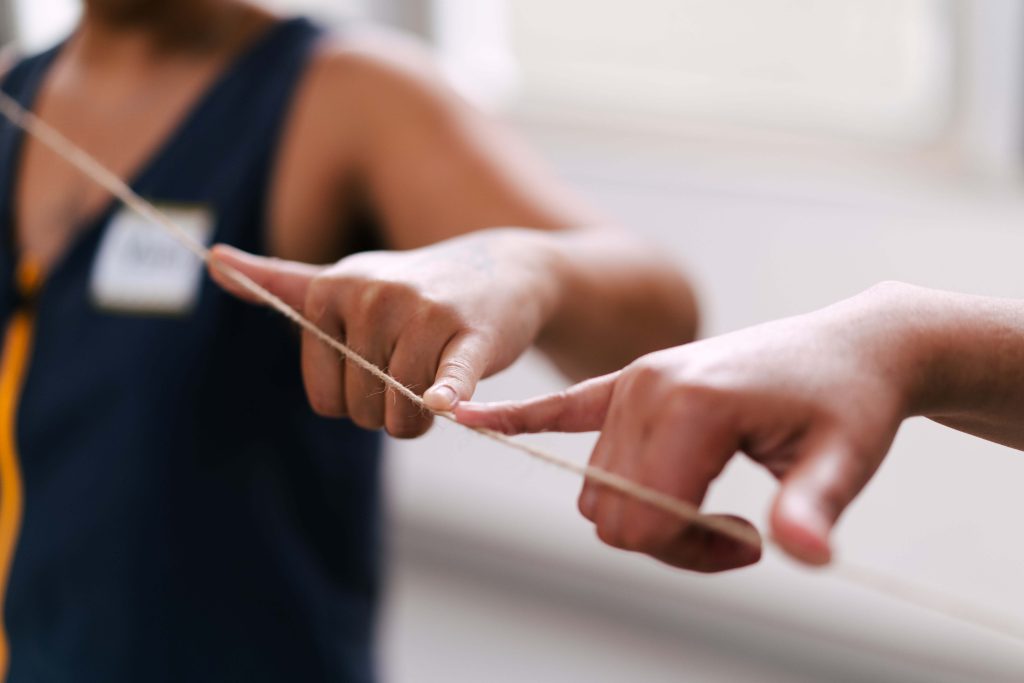


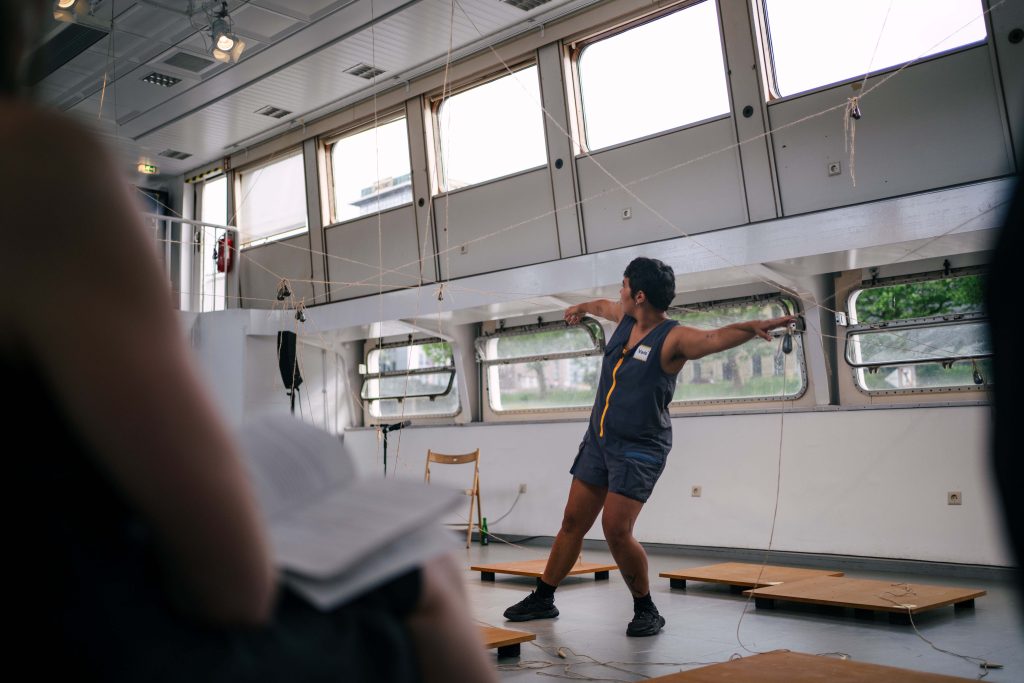
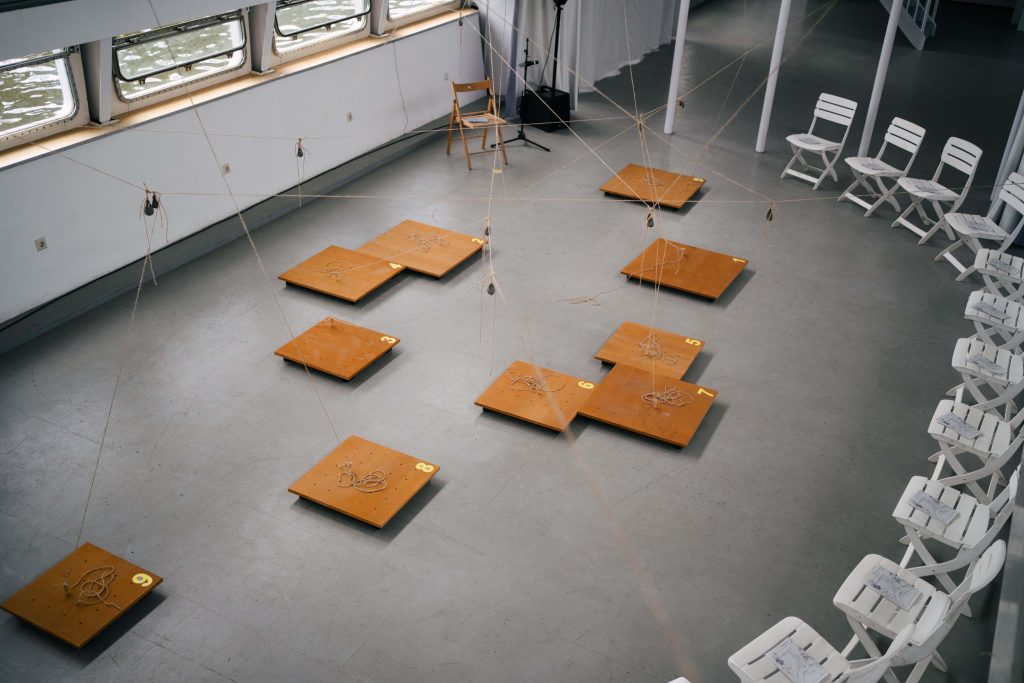
Mediciones: Exploration 01 is a performative reading that delves into the world of measuring instruments from both theoretical and personal perspectives. Using a structure composed of strings, weights, and floor modules, two performers engage with each other and the setup. One performer dictates the sequence in which the second performer reads a story about measuring instruments, introducing an element of control and fragmentation to the narrative. This interaction highlights the interpretive nature of measurement, revealing how instruments, much like the performers, impose order, prioritize certain perspectives, and leave others out. Through this performance, the underlying complexities of measuring instruments are revealed, deconstructed, and reimagined.
In the media arts, measuring, quantifying, and translating are common methods used by artists worldwide. Through sensors and other instruments, artists translate reality into abstract numbers, manifesting it into sound, visuals, or movement. However, these instruments carry assumptions that shape how we understand reality—from their design and materiality to the very act of measurement itself. Beneath their objective surface lies a complex interplay of choices and interpretations that subtly guide our perceptions of “reality as it is.”
In exploring measurements, measuring instruments, and the act of measuring, essential questions arise: What assumptions do we, as artists, bring to our work with these tools? How does the subject change when filtered through a measuring instrument? And what elements of experience resist quantification?
Performance Structure
The performance is divided in three main parts:
Part I
This section introduces the essential elements of measuring instruments, explaining their origins and significance. The main objective is to provide context for the audience, helping them understand the foundational concepts of the research. Here, we explore how these instruments are not just passive tools but active participants in the creation of knowledge, drawing upon Barad’s intra-action.
Scores
Performer 1:
- During this part of the performance, the first performer moves slowly, walking around the entire setting while observing their surroundings: the ropes, the modules on the floor, and the ceramic weights.
- After taking in the environment, the performer selects a module on the floor and announces its corresponding number, such as “2.1.” This choice is free and random; however, it is advisable to avoid modules 7 or 8 initially, as their associated texts are too complex for the introduction. These modules are more suitable for concluding this part of the performance.
- While the second performer reads aloud the text indicated by the first performer, the first performer adopts various poses that relate to measuring the space. Key references for these poses include the perspective view and the Vitruvian Man.
Performer 2:
- Performer two remains seated in the chair, waiting for performer one to indicate which text to read. In the meantime, she follows performer one’s movements with her eyes.
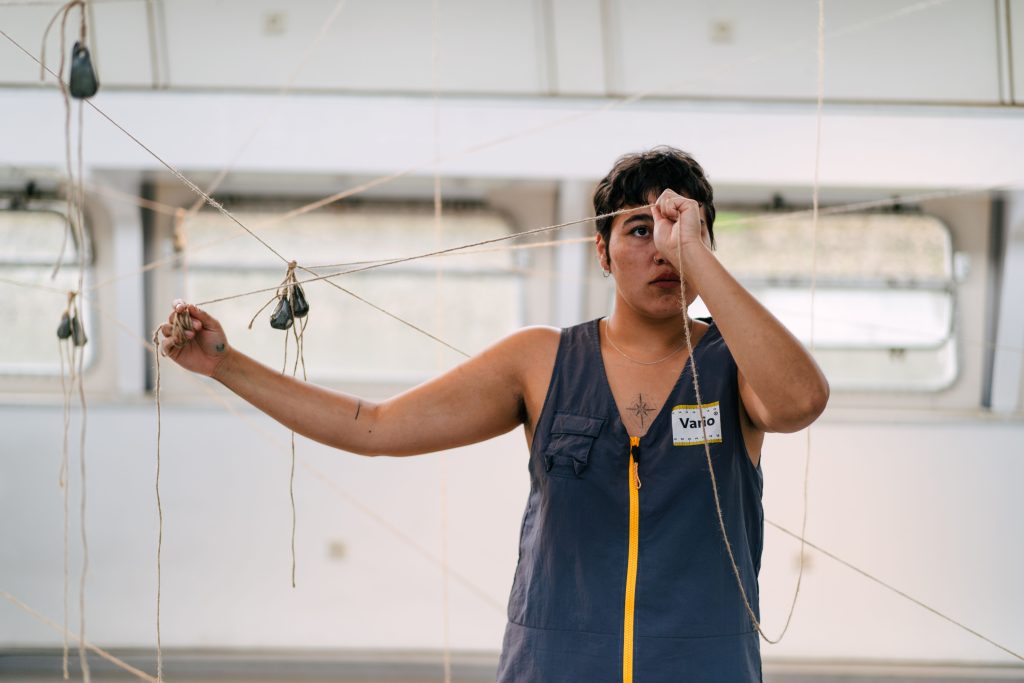
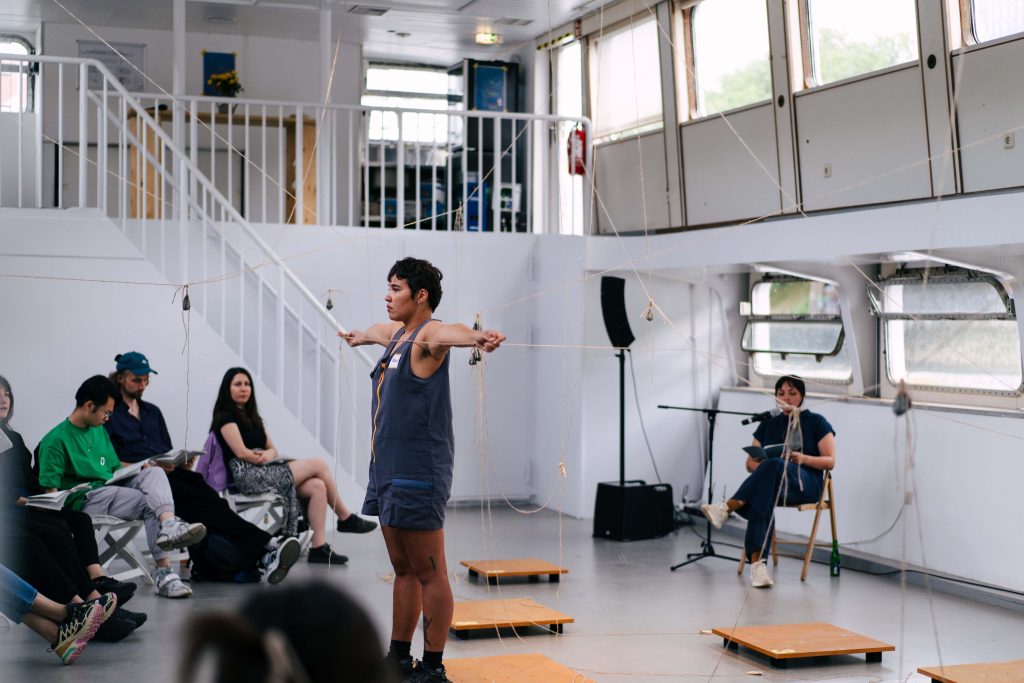
Transition
After the initial exposition, a transition period begins. During this phase, no text is read. Instead, there is a shift in perspective as the performer reading the text moves from position A to position B. This transition symbolizes a change in perspective, akin to the unlearning and reorientation emphasized in Sentipensar. The movement embodies the journey of integrating feeling and thinking, highlighting how new understandings emerge through this embodied process.
Scores
Performer 1
When reaching the last module of the first section, performer one must pull the chosen string as far as possible and for a moment after performer two finishes the final text. She then releases the string and all the other strings and weights drop and release.
Performer 2
Performer two waits for all the pieces of the structure to finish moving and slowly stands up. She spots one of the ropes and grabs it with one of her hands. She follows the trajectory of the rope walking from point A where she was sitting, until she slowly arrives at point B. On the way, she observes the structure and can also test and play with it.
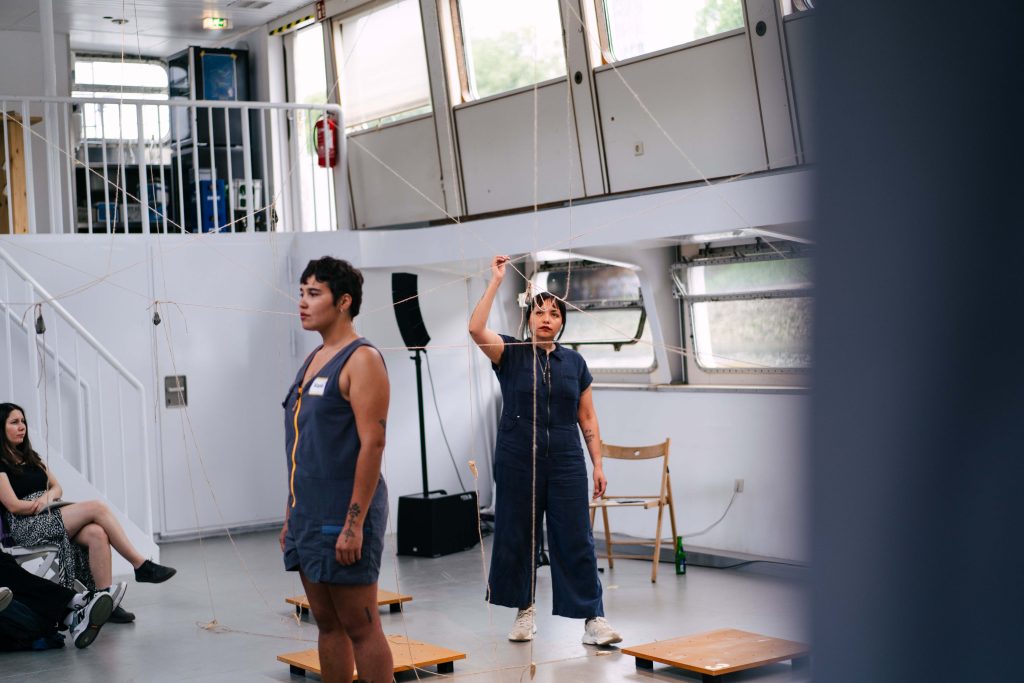
Part II: Upon reaching position B, the nature of the text changes. It moves away from purely academic discourse to reflect personal perspectives and creative motivations. This section offers a more intimate view of the work, emphasizing the performative nature of measuring. This aligns with the ideas behind Sentipensar, where reason and emotion are intertwined, and Barad’s intra-actions, where the subject and object co-constitute each other. The performer’s narrative illustrates how personal experiences, emotions, and intuitions are integral to the act of measurement and understanding, breaking the boundaries between objective and subjective knowledge.
Scores
Performer 1
- Here, the movements of performer one become much freer, faster, and more chaotic. No further references are made to measurements; instead, the focus shifts to interacting with the structure. Desired actions include running, entangling with the ropes, moving the wooden floor panels, listening the sound made by the ceramics weights, attempting to mislead with decisions, and playing with the expectations of both the audience and performer two.
- Everything that comes intuitively.
- Just like in the first part, performer one must choose a module and say its number out loud, such as “2.2.” While performer two reads the corresponding text, performer one can play with the plugs or the ropes.
- The idea is to connect the plugs back to the modules, but it is not mandatory in all of them.
Performer 2
- In this part, performer two can wait seated or standing for instructions from performer one. Sometimes, she can also play with the ropes.
- As she stops reading the final text, she leaves microphone and booklet on the chair and moves one floor module to the center of the setting. She stands on it. Then, the performer one does the same and stands besides performer one. The performance ends.
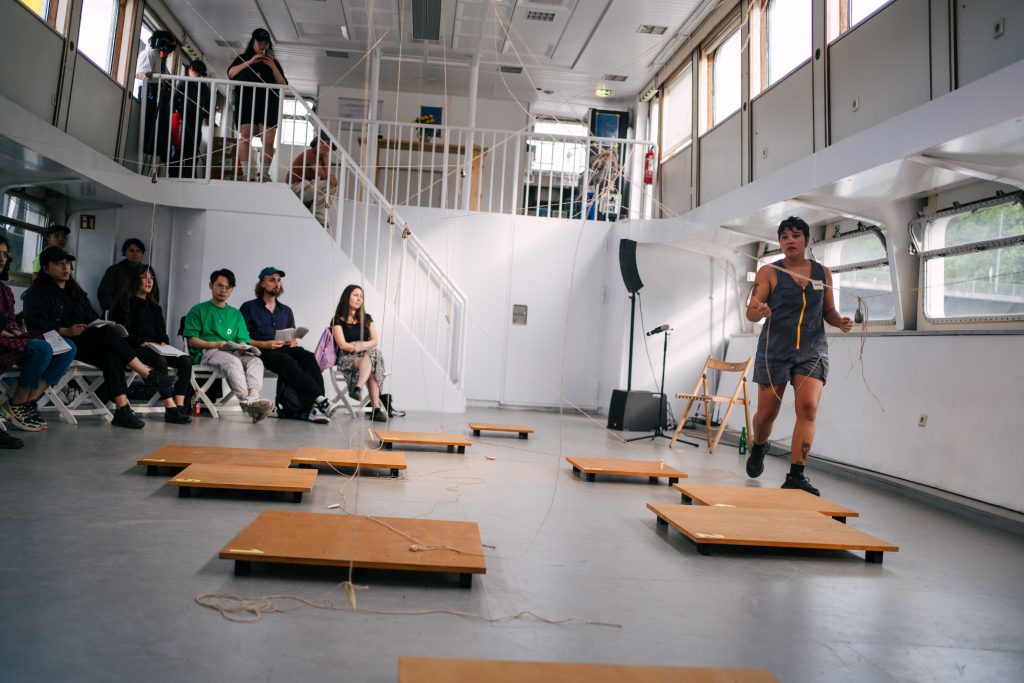
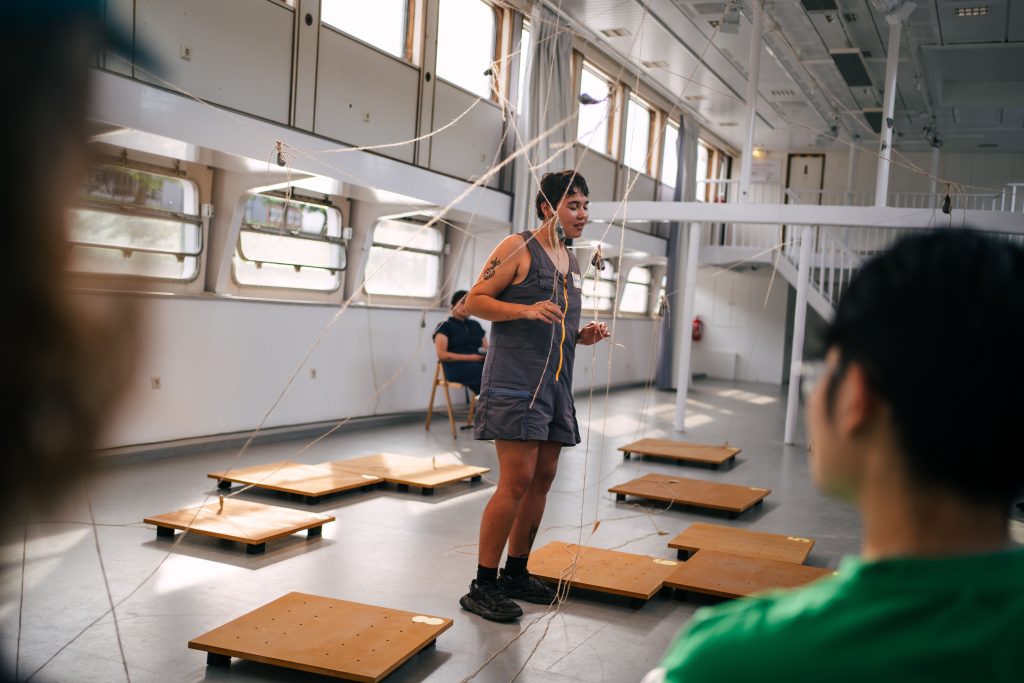
Initial and final states
The initial state of the setting has all the ropes tensioned and each one plugged into a floor module. Once all the excerpts have been read, namely, the first and second part, the second performer leaves position B, moves one of the floor modules to the center of the stage, and stands on it. The first performer does the same. Once both performers are standing on a module, the performance ends. The final state of the setting is unpredictable and depends on the decisions made by the first performer. Generally, most of the threads should be plugged into some floor module. However, some may not be, some may be hanging, or the audience may also make certain decisions, though this is not a general rule.
To start a new performance, the setting must return to its initial state. In other words, it must be reset.
Structure Materials
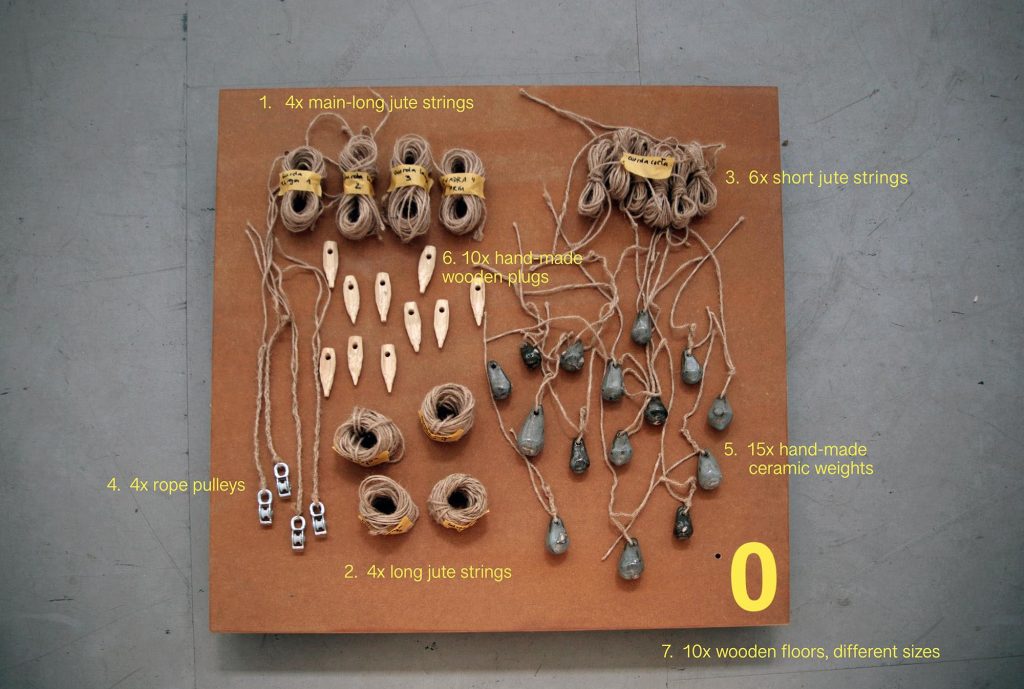
The Text
Part of the text read in the performance comes from a larger volume of text in which research on measuring instruments is condensed. To these fragments are added extra fragments that only appear in this small publication. These excerpts are most evident in Part II of the performance.
FIVE
Extract FIVE POINT ONE [5.1]
Here, I trace the modern science official narrative through three male European philosophers: Francis Bacon, Galileo Galilei, and René Descartes.
Bacon emphasized empirical observation and experimentation, advocating scientific methods grounded in measuring natural phenomena. Galileo believed in the mathematical organization of nature, famously stating, “nature is written in the language of mathematics.” Descartes viewed the natural world as a machine governed by mathematical laws, deeply influencing modern technology.
Inspired by these thinkers, scientists sought to quantify nature, creating instruments to precisely measure and actively explore the natural world.
.
.
.
Extract SEVEN POINT TWO [7.2]
From the book Measuring Infinity, Page 19.
In 1979, the Venezuelan poet Alfredo Silva Estrada wrote a poem in homage to Gego, or Gertrud Goldschmidt titled Variaciones sobre reticuláreas (Variations on Reticuláreas). The poem engages Gego’s experimentation with structure, space, light, shadow, line, and grid. Through metaphor, Silva Estrada alludes to the idea of freedom: the Reticulárea’s netlike “areas breaking free” and the “freedom of the hand in its simple measure.”’ Measure, as it happens, is a recurring motif evoked by the poet as he attempts to apprehend infinity:
“and the open that surrounds the open
the spirit breathing spirit
enveloping infinity between measured cords
two infinities facing each other
in the measure of each string”
Yet the act of measuring infinity is ultimately a paradox,
for unbounded space and time are inherently immeasurable.
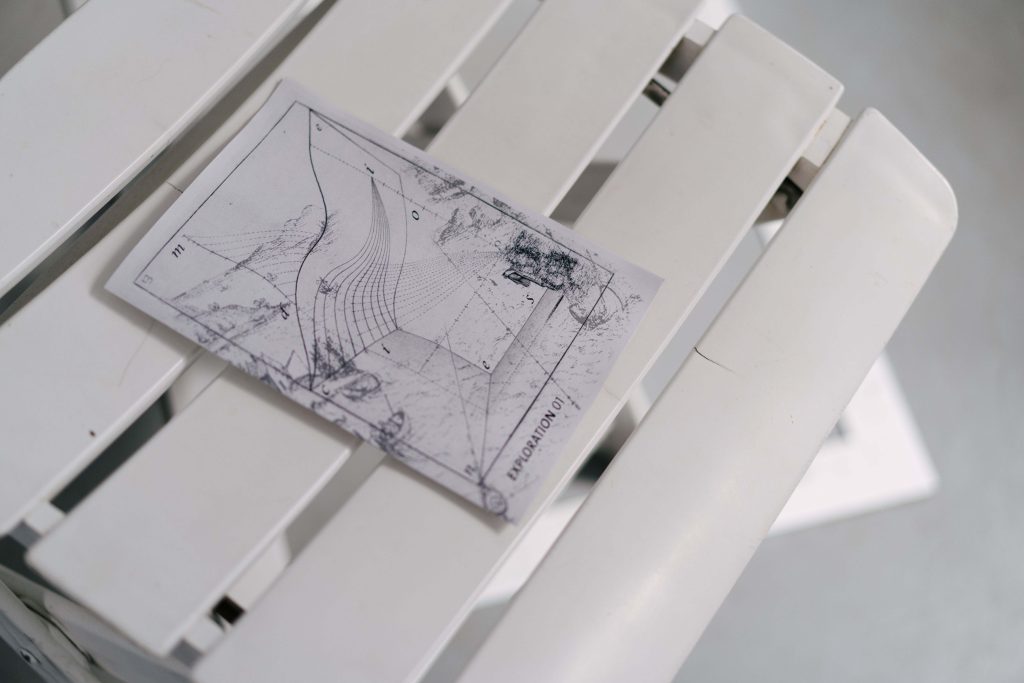
Size A5
Jahresausstellung 2024 Hochschule für Künste Bremen
Thanks to my thesis advisors Prof. Dr. Andrea Sick, Prof. Ralf Baecker and Dr. Nicolás Novoa Artigas. Every one of our meetings and their feedbacks helped to bring shape to my thoughts, intuitions and curiosity.
To Moira Meine Fuentes for her time and will to perform and dive with me into this weird performance. Thank you for all your professionalism and your friendship. Te quiero amiga.
To Víctor Artígas Rodríguez and Ícaro López de Mesa Moyano for their generous, loving and precise feedback.
To Irena Kukrić and Diego Gómez-Venegas for taking the time of reading my extensive text and send relevant commentaries.
To Constanza "Picha" Quinteros for proofreading my text <3 To Jimmy Liu for photo documentation and Gabriela Valdespino for video footages.
Finally, to all my friends and family who supported my over this months and years, specially Jörg Reichenberg and Trufita. Thank you both for your love and patience.